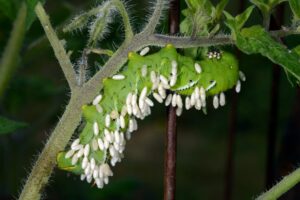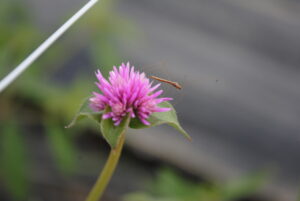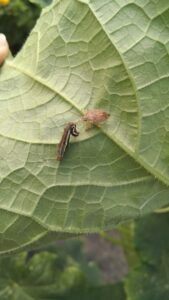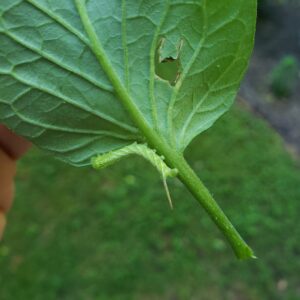The tobacco hornworm is one of the most devastating tomato pests in Indiana, if left unchecked. There are several natural enemies that help suppress this pest, such as stilt bugs (Figure 1), spined soldier bugs (Figure 2) and the parasitoid Cotesia congregata (Figure 3). Often, these natural enemies are not abundant until later in the season; the pests come first and their natural enemies take time to catch up. Therefore, scouting and managing the first generation of this insect with augmentation biological control or insecticides can be crucial.

Figure 3. A caterpillar that has been parasitized by the wasp Cotesia congregata. Photo by J. Obermeyer
I have recently detected the first generation of the caterpillars hatching and feeding on tomatoes in the West Lafayette area. When the caterpillars are young and small, they can be difficult to detect (Figure 4). However, when they reach the last stage before pupating, they will eat almost an entire plant. The key to successful management is always EARLY DETECTION. When the young caterpillars are present, the best thing to look for are holes in the leaves or missing portions along the margins. Flip them over and you will often find the small caterpillar. The second sign is the actual frass (poop) from the caterpillar accumulating on the plant tissue just below where it is feeding. Hornworms prefer to feed on the underside of the leaf and are positioned upside down, therefore when they defecate it rains down on the vegetation below. Scout your crop often and watch for the feeding and frass signs of hornworm infestations. Consult the Midwest Vegetable Production spray guide for product recommendations. There are a variety of biological and synthetic products available that have efficacy against hornworms. If relying on a biological product, remember that many times the insect has to consume tissue that has been treated and it may take time for the caterpillar to then die. Treating early and when the caterpillars are young will increase the efficacy of these products and result in less feeding damage.


